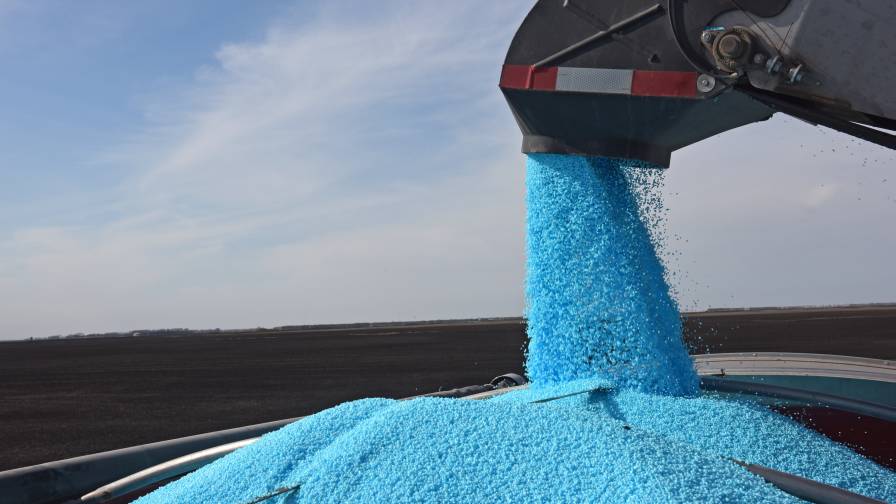Nitrogen Stabilizers Continue to Hold Their Own

Urea treated with N-Edge Pro nitrogen stabilizer by CHS is shown being loaded into spreader for application. Photo: CHS.
For the 2023 growing season, one of the standout categories among crop inputs was nitrogen stabilizers. In fact, according to Steve Carlsen, Agronomy Directory of Proprietary Products for CHS Inc., last growing season went exceptionally well for the nitrogen stabilizers.
“The 2023 growing season saw very strong performance of nitrogen stabilization and continuing adoption,” says Carlsen. “On a year-to-year basis, many growers have expanded their use of these products due to the positive results they have seen over the last several years. In recent years with some higher priced nitrogen inputs, growers sought to protect and maximize their higher-cost nitrogen. Now with prices receding, these products continue to be used because of the realized agronomic benefit and return-on-investment.”
According to Tim Laatsch, Director of Agronomy, North America for Koch Agronomic Services (KAS), part of the reason nitrogen stabilizers enjoyed a positive sales environment during 2023 tied back to the one “wild card” factor ever-present in each and every growing season since the dawn of agriculture – weather.
“Weather was a significant factor in 2023 with dry conditions throughout May and June,” says Laatsch. “Conventional wisdom might say early, dry conditions can help limit nitrogen loss, but we know it’s more complicated than that. In 2023, we saw scenarios where a nitrification inhibitor, such as CENTURO, helped ensure that enough nitrogen fertilizer remained in the soil to provide kernel elongation and grain fill to deliver a big late-season punch on yield.”
Clark Smith, U.S. Product Manager, Nitrogen Stabilizers and Row Crop Fungicides at Corteva Agriscience, agrees that weather played in the category’s performance during 2023 – and can be expected to remain a factor well into the current growing season as well.
“Corn growers are reporting anxiety about the apparent uptick in unexpected, extreme weather events,” says Smith. “Heavy rainfall in a short period of time is a particular concern for growers in the Corn Belt. These rains can quickly drive nitrogen loss, leading to lost yield potential and lost profit. Additionally, growers are increasingly concerned with their impact on the environment. They’re looking for ways to reduce the loss of excess nitrogen into the air and waterways.”
Looking Ahead to This Year
According to Smith, the 2024 growing season can be expected to play out in a similar fashion for nitrogen stabilizers, given that the key market drivers have remained virtually the same. “There are a few trends that continue to drive this market as we move forward in 2024,” he says. “We are seeing the success of the last several years carryover, as growers continue to experience the benefits of protecting their nitrogen for crop production. We are also seeing more programs and sustainability efforts that incorporate and incentivize the use of nitrogen stabilization driving growth. Nitrogen is one of the most essential inputs and cost for growers and we continue to see increased grower interest in how to get the most out of this key crop input.”
KAS’ Laatsch agrees with this latter point. “Protecting nitrogen investments with a stabilizer is not only a best management practice, but also crucial for optimized yields and nutrient efficiency,” he says. “In 2024, growers who protect their nitrogen will be better positioned to minimize their potential nitrogen losses and ultimately maximize production. Additionally, corporate sustainability initiatives for water and air quality are driving adoption of nitrogen stabilizers in both the U.S. and Canadian markets and we expect that trend to continue. Urease inhibitors, nitrifications inhibitors, and dual inhibitors all have important 4R stewardship benefits to reduce nitrogen loss to air and water while enabling the use of the right nitrogen rates. They also provide flexibility on fertilizer placement and timing to ensure that more nitrogen is converted to crop yield.”
Still, adds Laatsch, the desire to improve profitability as commodity prices soften somewhat from their 2023 levels, might convince some growers to “take a chance” and not apply nitrogen stabilizers. This would be a mistake, he says.
“With continued pressure on profitability in 2024, growers will have to make many decisions that can have positive and negative consequences for their crops,” says Laatsch. “But one decision that could have the greatest negative effect on their bottom line is skimping or skipping the use of a nitrogen stabilizer.
“Nitrogen should be protected consistently, year in and year out,” he continues. “Science shows us over and over that applying more untreated nitrogen is not a wise strategy. First, uncertainty about the weather presents a risk that cannot be ignored and must be proactively managed. We also know from years of research that we lose even higher percentages of applied nitrogen, when we apply more untreated nitrogen. Additionally, we routinely see higher nitrogen use efficiency and yields with the right rate of stabilized nitrogen than with higher rates of un-stabilized nitrogen.”
Active Ingredients Considerations
Of course, says Laatsch, one of the major considerations for ag retailers and their grower-customers when it comes to choosing a nitrogen stabilizer is the active ingredient involved in its production.
“With many inhibitor products on the market claiming nitrogen stabilizer benefits, it’s important for growers to ask questions and understand the efficacy rates of active ingredients,” he says. “A ‘too good to be true’ solution may be just that and a quick fix won’t always provide season-long protection. While some stabilizers may claim to deliver the same results, the reality is low-rate products — those with agronomically ineffective loads of active ingredients — are not the same as products with higher active ingredient concentrations.”
Corteva’s Smith concurs with this view. “It’s important to note that we continue to see new products come on the market calling themselves ‘nitrogen stabilizers’ and making very big claims without the data to back up those claims,” he says. “So, it’s essential for retailers to work with growers to research these products, check the active ingredients and make sure there is proof behind their claims.”
Smith adds that Corteva’s Optinyte technology (nitrapyrin) in N-Serve and Instinct NXTGEN nitrogen stabilizers has been a leader in the market for almost 50 years, with proven results in more than 1,000 field trials and university studies. “There are products on the market claiming to offer the same benefits as Optinyte technology, but the data doesn’t agree,” he says.
According to CHS’ Carlsen, his company also focuses heavily on the active ingredient question with its nitrogen stabilizers. And in CHS’ case, this involves the use of two components being utilized in the formulation instead of one.
“N-Edge Pro is a stabilization product combining two of the most effective nitrogen stabilizing active ingredients — NBPT (N-(n-butyl) thiophosphoric triamide) and DCD (dicyandiamide) — for both above and below ground protection of nitrogen inputs,” he says. “Many product offerings on the market only protect against a single form of nitrogen loss. By effectively using two active ingredients in N-Edge Pro, we can better protect nitrogen vs. sacrificing with other product options.”
Regardless of which nitrogen stabilizers growers decide to use in their fields during the 2024 growing season, Corteva’s Smith emphasizes the costs involved with purchasing these products will end up being “worth it” once harvest time rolls around.
“It’s impossible to speculate exactly what could happen in the future,” he says. “However, with the nitrogen fertilizer prices being, generally, lower than they have been over the last couple years, we may see some corn growers deciding not to use stabilizers. These growers may think the risk of loss isn’t as great a concern with lower nitrogen prices or some may think they can afford to add more nitrogen later in the season if they experience loss. We would caution against this thinking — particularly the idea of simply adding more nitrogen later in the season. Additionally, there is a misconception that a stabilizer isn’t necessary with spring or sidedress applications. We would advise growers to use a stabilizer with every application. If, for example, a heavy rainstorm follows application, unstabilized nitrogen will do little good for a corn crop – and, instead, put more nitrates into the environment while costing the grower money.”






